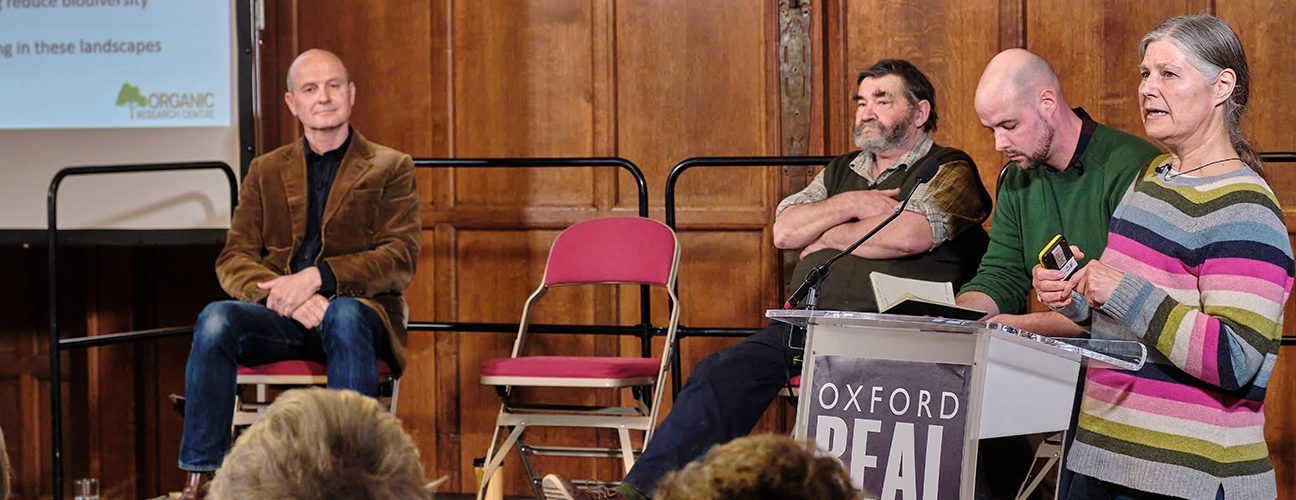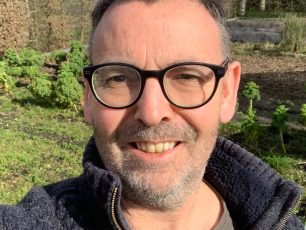Oxford Real Farming Conference: seeking common ground
The new year started as the old one left, with incessant rain and rising floods – a reminder of how vulnerable our profession is in a changing climate. The spirits needed lifting through the fellowship of others. The Oxford Real Farming Conference provides that affirmation we all need of being on the right path, together with the challenge of alternative views and the inspiration of fellow travellers…
Bigger than ever, with over 150 sessions and 400 speakers spread over multiple venues in a corner of Oxford, the choice could have been overwhelming. Fortunately, the recording of sessions means that ORFC 2024 can keep giving through allowing us to catch up on and watch those sessions we couldn’t attend. In this blog I pick out some of the highlights that shine a light on farmers and growers that are transitioning to more sustainable and resilient farming systems.
Livestock in the Landscape: Optimal Carrying Capacity of Land for Livestock
This session, organised by Agricology, and chaired by Matt Smee, featured Lindsay Whistance with Simon Fairlie and Richard Gantlett. It presented ideas and approaches that look to reframe the case for livestock in the landscape. It didn’t shy away from asking difficult questions.
Lindsay Whistance stated her concerns as to how livestock is represented in the narrative around climate change, and how we can look at animals in a different light. Human population is the elephant in the room, and needs to be talked about in a constructive manner. Current farming practices are contributing to a third of global GHG emissions and animals play a large part in that. There is compelling evidence that animal production, as currently practiced, is unsustainable. Lindsay argued that the three major actors in the current food system – humans, domestic animals and ecosystems – are unequally balanced. Perhaps it is time to re-balance the relationship away from humans, allowing domestic animals and ecosystems to play more of a part? She emphasised that livestock play a crucial role in functioning ecosystems, improving fertility, managing weeds and making room for other species to live and thrive, with associated biodiversity benefits. Under-grazing can be as damaging to ecology and landscape as over-grazing. With no apex predators, population control of species needs to be managed. She concluded: “There is a place for human food – animal-derived products – but this (meat, dairy etc) should come as a consequence of planetary health and ecosystem health, first and foremost.”
Simon Fairlie highlighted the role that livestock play in global agriculture in recycling ‘food waste’ and how that has been disrupted by health and disease scares and regulations. Even though grain fed to livestock has a high impact environmentally, it can also be necessary as there needs to be a feed buffer to ensure that there is enough to feed people in a poor year. “Animals are a necessary part of an agricultural system” said Simon, “when there are too many of them, we might as well eat them, and certainly we need to milk them.”
Organic and biodynamic farmer Richard Gantlett‘s Yatesbury House Farm in Wiltshire is storing 10x more carbon than it is emitting. He explained how their livestock fit into the landscape. They use a system of rotational grazing which allows the herd instinct to manifest itself – grazing / browsing / drinking together. Cattle are moved to fresh pastures (diverse leys) before the grazed plants re-grow – every 5-6 days in spring, 1 month in autumn. They are changing the way they rotationally graze the cattle by fencing in the crops, not the cattle, developing a forest farm approach that allows the cattle to roam in the woods, accessing shelter and diverse nutrition through browsing. “We need to respect and revere our cattle. We aim to respect all life on our farm. It’s not the type of food that is important, it’s the system that the food has been grown in.” Richard’s final words were: “If we could listen more to nature – plants and animals, fungi and insects – how would nature tell us to farm? If we could talk to cows? What would the world be like if we were all consciously on nature’s team? Wouldn’t farming be much easier?
Look out for a series of podcasts from Agricology on the topic of optimal carrying capacity of land for livestock that will lead on from these discussions. They will delve more into the nitty gritty of how farmers can work out what their optimal carrying capacity is and the various balancing acts that need to go on i.e. preserving or maintaining biodiversity versus needing to balance the books versus optimal conditions for maintaining maximum animal health.
Perennial Veg: Promise and Propagation
Perennial vegetables are “totally on the map now” said Mandy Barber, and her business ‘Incredible Vegetables’ has indeed taken off. Moving the nursery to Guy Singh-Watson’s Baddaford Farm, in Devon, three years ago was ‘a game-changer.’ There has also been real interest from market gardeners wanting to introduce perennial vegetable crops to annual cropping systems. But, there are issues of how to integrate perennials into farming systems, how to get the plant material, and how to persuade people to eat them. As Guy Singh-Watson remarked in an entertaining talk that occasionally strayed onto the subject, “I don’t want to run another artisan niche food business, I want to feed people at affordable prices and that means that everything has to be mechanised as far as possible in an economy where we only pay 1.6% of GDP to our farmers.” It was great to hear about work to scale-up perennial production through micro-propagation, and the challenges of doing so within the organic regulations. That too could be a ‘game-changer.’
Managing Reduced Tillage in Horticulture
This important topic has been covered by Agricology before. See No-till for growers: realising the promise of soil health in organic horticulture. Part 1 – Helping growers who want to make the change and No-till for growers: Part 2 – Soil health practices for growers and Mulch systems and rotational no-till in vegetable farming. This was a fascinating session, focusing on strip tillage featuring three growers who have been part of the Innovative Farmers field lab. Strip tillage involves tilling narrow strips into a cover crop, into which the cash crop is then planted or drilled, while leaving the areas between the cultivated strips as undisturbed cover crop/residue. All growers agreed that the crop can take longer to get going in a strip-till system, but can be more robust. Management can be a challenge but there are soil health benefits. Listen to the session here.
Fertilisers In the Landscape
This workshop discussed the benefits of trees within the landscape. One area of interest is that of perennial mobile green manures (see also Sustaining our soils: Getting the balance right); trees, shrubs and perennial plants grown in permanent areas to provide nitrogen-rich leaves to fertilise horticultural and arable land. It’s an experimental technique being trialled on a small scale by a grower group in mid-Wales. It has real potential and they are in the process of setting up an Innovative Farmers field lab to investigate further. Listen to the session here.
Soil Health at Scale
This fascinating session featured two ‘exceptional farmers’ and passionate soil enthusiasts; grower Iain Tolhurst (Tolly) of Tolhurst Organic and ‘biological nutrition farmer’ Tim Parton, exploring the common ground (a love for earthworms, respect for life) and the differences (tillage vs glyphosate) between their respective systems. As the session was entitled ‘Soil health at scale’ one questioner commenting on the fact that both speakers were exceptional, asked if you need to be exceptional to do what they do. Tolly said: “No, but you need empathy for nature, empathy for the environment and you need to think about how the soil needs to be treated.” Tim responded “You don’t need to be exceptional. I am passionate. You just need to care. It is all about enjoying the journey.” Find out more here and watch the session below.
The Search for Common Ground: Reconciling Farming and Academic Research
I have to declare an interest in this session, as part of the Steering Group of the Agroecology Research Collaboration. Organic Research Centre’s Julia Cooper talked about her experiences as an academic and soil scientist and more recently participative research projects at ORC such as Organic at the Heart and living labs as part of REFOREST. It was great to hear Holy Silvester of Trill Farm, talking about her research, supported by ‘Experts in Your field‘. Angelina Sanderson Bellamy, Professor of Food Systems at UWE Bristol believes passionately in co-production and stakeholder engagement and making our food systems environmentally sustainable, healthy and accessible for all. Ben Adams is an Oxfordshire farmer and consultant who operates a series of farm trials each year, which has significantly changed the way he farms. The common ground? Communication and collaboration are key. Empower farmers, involve them from the start. Ben said: “We as farmers and growers have the power to share this knowledge between us – that’s the ripple effect!”
Bale Grazing as an Effective Livestock Outwintering Strategy
This workshop features participants from the Innovative Farmers field lab How Does Bale Grazing Affect Forage Quality And Soil Health? sharing their insights into their out-wintering strategies, including costs, benefits, impacts and lessons learned after several years of testing the approach. Chaired by Nikki Yoxall, the session first outlines what bale grazing is and the intentions behind the research; principally trying to understand the benefits to soil health and forage quality after bale grazing. Anecdotal evidence shows that grass comes back better and farmers can get better hay cut and an extra graze the following year through using bale grazing. We hear from four different farmers; Andrew Steele from Treflach Farm in north Shrophshire, Claire Beaumont of Gowbarrow Hall Farm in Cumbria, Ian Horsley who runs Garton Hardy Farming with his wife as part of Baston Hall, a small diversified regenerative farming estate, and Silas Headley-Lawrence who manages FAI Farms on the edge of Oxford. Find out more here, watch the session below.
Also check out: The Cann Mill Project- Widening Access To Population Wheats In The South West
ORFC audio files on Soundcloud

